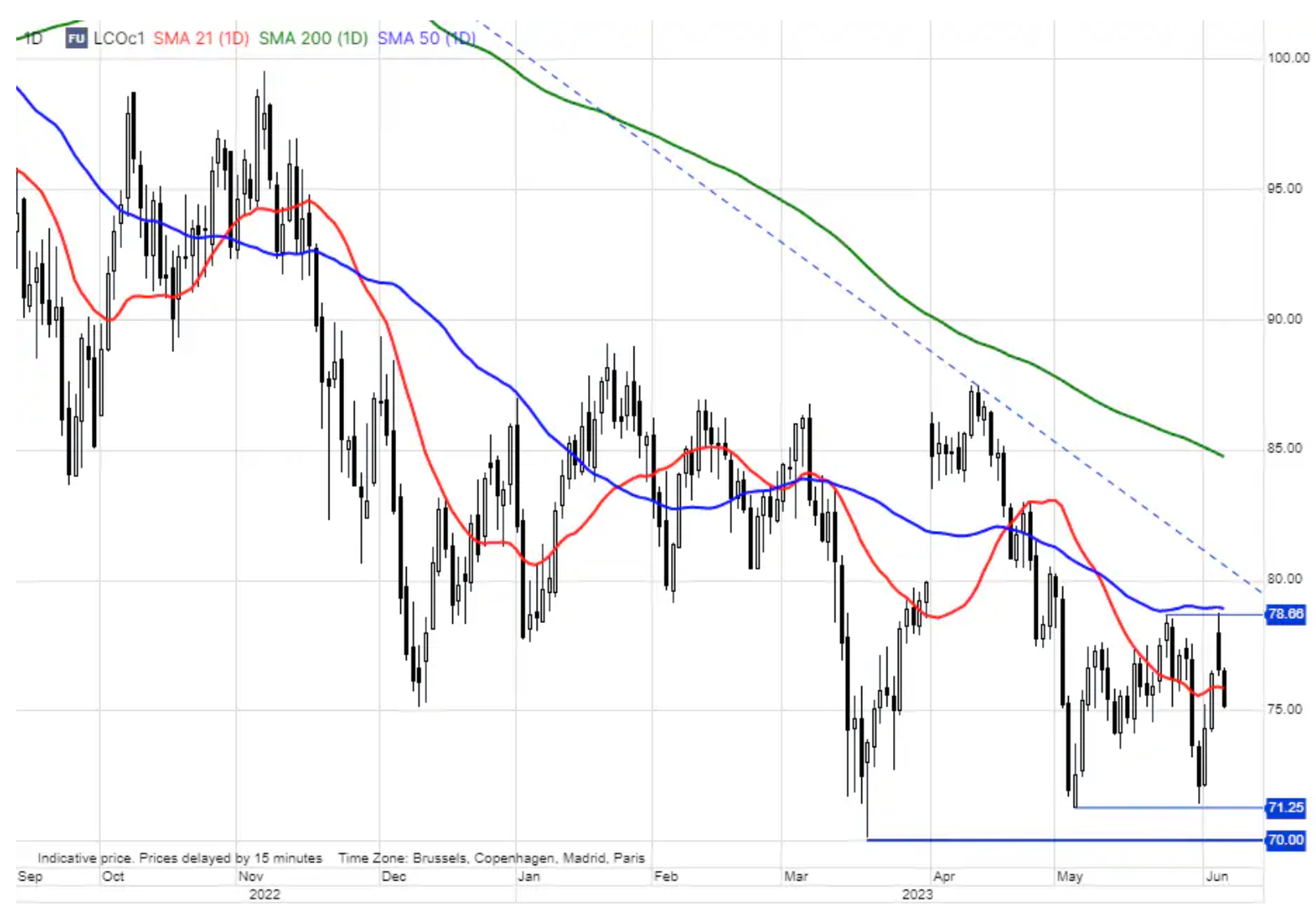Rapid turnaround in oil market despite production cut in Saudi Arabia
Long expected OPEC+ meeting last weekend once again gave the market a lot to think about - both in the context of new information and changes. In general terms, this information, including Saudi Arabia's decision to unilaterally cut production by one million barrels a day - for now only in July - should be seen as slightly upward, as it may contribute to a reduction in supply in the market. However, the market took a different perspective, basically recognizing that OPEC doubts its own projections for demand growth of 2023 million barrels per day in 2, most of which would materialize in the second half of the year.
In the last month, analysts strongly believed that the supply on the oil market would be limited in the second half of the year, while OPEC's own data indicate that in the second half of the year, global demand for crude oil will exceed supply by an average of about 1,5 million barrels a day.
From this it can be concluded that concerns about global growth and demand forecasts continue to be the main driver for now, not only in China - the world's largest oil importer - but also in the US and other key oil consumption regions. After last week's short-covering wave ahead of the OPEC meeting, sellers are starting to emerge again, primarily macro-focused funds looking to hedge against such a slowdown. In addition, the market may also be concerned about further developments in the event that market conditions in the coming months prevent Saudi Arabia from increasing production again, due to both increased production in other countries and an economic slowdown causing barrels to fail to find buyers.
Saudi Arabia wants more expensive oil
Given the fall in prices observed since the announcement, preliminary calculations suggest that, from Saudi Arabia's perspective, for a XNUMX million barrel cut to be revenue-neutral, oil price would have to increase by $10. Saudi Arabia tends to reduce exports during the summer months to meet higher domestic demand, so the negative impact on revenues will therefore be even more severe, but at the same time, even lower exports should help to stabilize and ultimately increase prices.
OPEC's emphasis on supply management is likely to confirm the view of creating a soft bottom under the market, but whether it will be $70 Brent crude or even lower remains to be seen, with a larger drop unlikely. Growth potential seems equally unlikely as long as the market is focused on worsening economic prospects. From a technical perspective, the $78-80 Brent area is likely to provide significant resistance, and further down funds are unlikely to change their negative view on price until there is a return above $80.

There has been a lot of talk lately about speculative investors, in particular the reluctance of oil producers for this group of traders, which ranges from small family-owned investment firms to large hedge funds and trend-following funds (CTAs). Funds in this broad group use a variety of strategies - the most common being a macro or purely price strategy where momentum and technical analysis determine entry and exit levels. These funds follow the markets more than they drive them, buying when they are strong or selling when they are weak, until the technical and/or fundamental outlook changes enough to warrant a cut or a change in direction. These changes are not immediate, but are usually spread out over several days, which means that a short covering period, as was the case last week before the OPEC+ meeting, may not change the overall attitude that many still hold short.
The behavior of the aforementioned group of traders can be monitored thanks to weekly reports Commitment of Traders US Commodity Futures Trading Commission, CFTC). In this report, clearing members in various futures markets must report customer holdings above a certain amount, broken down into four main categories for commodities: producers/traders/processors/users, swap dealers, fund-managed money and other reportable entities. Our weekly reports focus primarily on fund-managed money, but the other reportable entities also count as "buy side" and should be taken into account to get the full picture.
Summation
In the week ending May 30, before short overlapping took place ahead of the weekend meeting, the total speculative net long position in the five major oil and oil futures contracts was 387. contracts, divided into 439 thousand. contracts, a long net position in Brent and WTI oil and 52 thou. contracts, the net short position on fuel products, mainly due to the amount of PLN 118 thousand. short diesel contracts.
Overall, the total net long position, as shown in the chart below, is close to its lowest level in more than a decade, underlining that the market is already close to worst-case pricing, and therefore we see an increased risk of rebuilding long positions. However, as we mentioned, speculative traders are not the ones who sell when they peak or buy when they dip to lows, and for that to change, it would be necessary to change that technical and/or fundamental forecast. According to this assumption, speculative investors will eventually become a factor supporting prices, and when they do, they will help Saudi Arabia drive oil prices up.
About the Author
 Ole Hansen, head of department of commodity market strategy, Saxo Bank. Djoined a group Saxo Bank in 2008. Focuses on providing strategies and analyzes of global commodity markets identified by foundations, market sentiment and technical development. Hansen is the author of the weekly update of the situation on the goods market and also provides customers with opinions on trading goods under the #SaxoStrats brand. He regularly cooperates with both television and printed media, including CNBC, Bloomberg, Reuters, Wall Street Journal, Financial Times and Telegraph.
Ole Hansen, head of department of commodity market strategy, Saxo Bank. Djoined a group Saxo Bank in 2008. Focuses on providing strategies and analyzes of global commodity markets identified by foundations, market sentiment and technical development. Hansen is the author of the weekly update of the situation on the goods market and also provides customers with opinions on trading goods under the #SaxoStrats brand. He regularly cooperates with both television and printed media, including CNBC, Bloomberg, Reuters, Wall Street Journal, Financial Times and Telegraph.






















![Forex Club – Tax 9 – Settle tax on a foreign broker [Download the Application] Forex Club - Tax 9](https://forexclub.pl/wp-content/uploads/2024/02/Forex-Club-Podatek-9-184x120.jpg?v=1709046278)
![Trading View platform – solutions tailored to the needs of traders [Review] trading view review](https://forexclub.pl/wp-content/uploads/2024/03/trading-view-recenzja-184x120.jpg?v=1709558918)
![How to connect your FP Markets account to the Trading View platform [Guide] fp markets trading view](https://forexclub.pl/wp-content/uploads/2024/02/fp-markets-trading-view-184x120.jpg?v=1708677291)
![How to invest in ChatGPT and AI? Stocks and ETFs [Guide] how to invest in chatgpt and artificial intelligence](https://forexclub.pl/wp-content/uploads/2023/02/jak-inwestowac-w-chatgpt-i-sztuczna-inteligencje-184x120.jpg?v=1676364263)


![WeWork – the anatomy of the collapse of a company valued at $47 billion [WeWork, part II] wework bankruptcy story](https://forexclub.pl/wp-content/uploads/2024/04/wework-bankructwo-historia-184x120.jpg?v=1711729561)
![Adam Neumann – the man who screwed up Softbank [WeWork, part AND] adam neumann wework](https://forexclub.pl/wp-content/uploads/2024/04/adam-neumann-wework-184x120.jpg?v=1711728724)





![How to transfer shares to another brokerage office [Procedure description] how to transfer shares to another brokerage house](https://forexclub.pl/wp-content/uploads/2024/03/jak-przeniesc-akcje-do-innego-biura-maklerskiego-184x120.jpg?v=1709556924)

![The most common mistakes of a beginner trader - Mr Yogi [VIDEO] Scalping - The most common mistakes of a beginner trader - VIDEO](https://forexclub.pl/wp-content/uploads/2024/03/Scalping-Najczestsze-bledy-poczatkujacego-tradera-VIDEO-184x120.jpg?v=1711601376)
![Learning patience: No position is also a position - Mr Yogi [VIDEO] Scalping - Learning patience - No position is also a position - VIDEO](https://forexclub.pl/wp-content/uploads/2024/03/Scalping-Nauka-cierpliwosci-Brak-pozycji-to-tez-pozycja-VIDEO-184x120.jpg?v=1710999249)
![When to exit a position and how to minimize losses - Mr Yogi [VIDEO] Scalping - When to exit a position and how to minimize losses - VIDEO](https://forexclub.pl/wp-content/uploads/2024/03/Scalping-Kiedy-wyjsc-z-pozycji-i-jak-minimalizowac-straty-VIDEO-184x120.jpg?v=1710336731)









